Back To The Future: The Game – Full Season Review
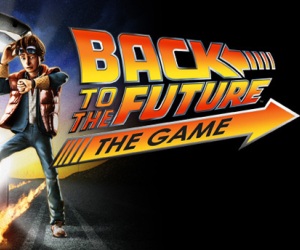 Game: Back To The Future: The Game – Episode 1-5
Game: Back To The Future: The Game – Episode 1-5
Developer: Telltale Games
Publisher: Telltale Games
Available on: Windows PC, Mac, iPad, PlayStation 3
When developers are handed a much-loved franchise, there will be a certain amount of pressure placed on their shoulders. But when that franchise is over twenty-five years old and is widely regarded as one of the best family adventures ever made, the pressure must be a lot harder to bear. And so it is that Telltale Games were given permission to turn their episodic, season-based Adventure Game creation model to the Back To The Future series. The first episode emerged at the end of last year, but now that the first season has finally reached its climax, we are here to look back into the past and judge whether it was a wise move to go Back To The Future.
STORY: The story is obviously the driving force behind the series. Whereas most games will be gameplay-centric, it is clear almost from the get-go that Back To The Future: The Game is going to be half game, half interactive movie. Over the five episodes, the balance between puzzling sections and plot-progressing cutscenes and conversations is definitely skewed toward the latter. But for a series as loved as this, then the protection and preservation of the characters and their emotional bonds to the player is of the utmost importance.
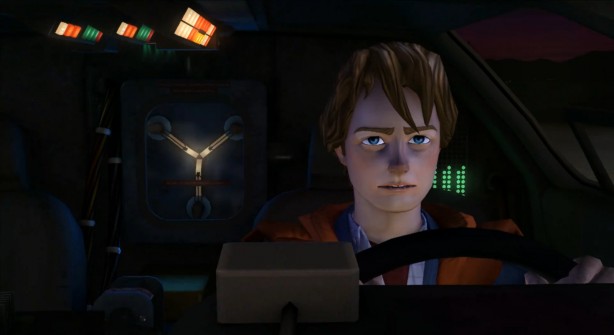
To their credit, Telltale Games have generally done a very good job of this. The tone and feel of the adventure is very faithful to the film series. The story is set after the end of the third film, and Doc has been missing for several months. Having not paid his rent, the city wants to auction off his lab, and with it, his possessions. Marty goes to try and stop the auction, but discovers the DeLorean time machine has re-appeared in the present day, piloted only by Doc’s pet dog, Einstein. Returned via an automatic retrieval system (designed in case Doc was ever in trouble) Marty soon realises that is it solely up to him to rescue his friend and once again go back in time.
The driving force behind the movies is the relationship between Marty McFly and Doctor Emmett L. Brown, or Doc. This relationship and the emotions involved in it are represented nicely in the game series, with fans of the films likely to feel the same pangs of excitement or emotion that Marty goes through during the story. These two characters are exceedingly likable, something that is exploited repeatedly by placing the pair in peril, usually as a result of mistakenly altering the time-space continuum, as you do.
Conventions from the films are repeated throughout the series. Characters you see in one time zone are encountered in the past in their younger form, Marty awakens disorientated from a “dream” (only to be comforted by his mother) and is constantly late: all recognisable themes from the films that fans will relish. And don’t worry, Biff gets plenty of screen-time.
But the story is more than just fan service. Telltale have created a complex story that goes from 1985, back to 1931 and forward again through several alternative time-lines where events have become skewed and distorted. The feeling that actions you take in the past will effect the future world is a strong one, and gamers will find themselves constantly thinking of how one action may cause dire implications further down the line. This is always a crucial factor of any successful time travel story, and Telltale are always playing with the idea that even the smallest action could result in a vastly different future that Marty will have to fix in order to return to his normal life.
The fact that the game has a high proportion of cinematic cutscenes and character conversations to gameplay gives it the feel of a movie or cartoon. It feels as if it could be an extension of the original trilogy, and at times could be considered more of a fourth film than a game.
Consequently, this does take away from the fact that it is marketed as a video game. Features such as the “In the next episode” trailers at the end of each of the first four parts of the season help ramp up the cinematic atmosphere, and with it the player’s excitement to experience the next instalment and find out what happens next. This game is a fairly accurate representation of what Back To The Future might have been like had it been a miniseries: a sort of cross between Back To The Future and Quantum Leap.
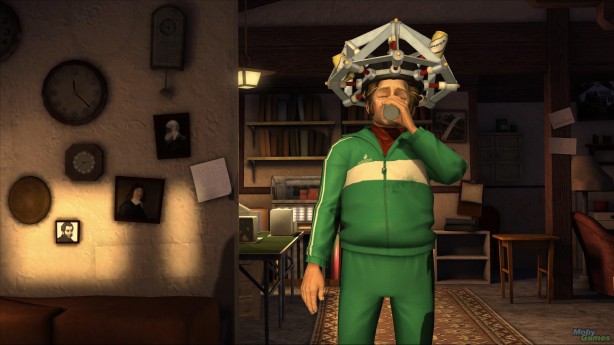
GRAPHICS: Those expecting to see a photo-realistic Marty McFly and a fully re-created DeLorean will definitely be disappointed. In a similar way to all of their other episodic games released so far (Jurassic Park looks like it will be an exception in the future), Back To The Future: The Game is presented in a simplified cartoon-style format. The main characters are all recognisable caricatures of their movie counterparts, but are fairly basic simplified character models.
Aside from the main protagonists, some of the other supporting characters do seem a bit plain in comparison, and because of this, the graphics do seem somewhat dated. Locations too, whilst clearly showing areas we are familiar with from the films, are low on incidental detail, and the shadow and background effects are all rather basic. Of course, upping the detail levels and resolutions will add a bit of spit and polish to proceedings, but when the backdrop of an area has been modelled in a simple way, there is only so many ways you can dress it up.
Overall, animations are a bit hit and miss. Some of the background and incidental animations (when characters are idle, or minding their own business) can be quite basic or lazy. Short, simple cycles will repeat, and NPCs appear to have very little AI. Further to this, lip-syncing isn’t entirely accurate. But then sometimes (usually in the case of the major characters), much more attention has been paid to the little details. For instance, in the films, George McFly (Marty’s father) does a distinctive arm gesture when trying to emphasise something, and this is faithfully recreated in the game. For a cast of characters as small as that found in this game, it is just a shame that some of the lesser figures haven’t received more attention.
However, the impressive thing about the graphical presentation is the little touches that make you feel like you are playing a part in one of the titular films. Right down to the font used for the opening credits and subtitles, there are a lot of little touches that are authentic to the presentation of the films, which adds to the immersion. Seeing the different locations such as the Hill Valley Clock Tower and the Cafe change as you travel through time is always interesting, and the team successfully adapts each area to reflect design styles and popular culture of the time – even the advertising hoardings change to time-authentic adverts as we travel back and forth.
SOUND: From the first note of music right down to the sound effects of the DeLorean doors opening and closing, Telltale have hit a definite home run with the audio. In terms of music, the team have been given access to much of the authentic original score (composed by Alan Silvestri), along with a few of the popular Huey Lewis & The News licensed tracks. The original score included a huge number of pieces with great tonal variety, but where extra music was needed to fill in the gaps, the music team at Telltale have done an admirable job of intertwining Back To The Future musical themes and melodies into new compositions, so that all of it fits together as a coherent whole. And hearing “Back In Time” at the end of an episode really puts a smile on your face!
When it comes to voice acting, the game features a great mixture of actors from the films, and very talented voice artists. Christopher Lloyd reprises his role of Doc – with all the vigour and sardonic wit we remember, but for obvious health reasons Michael J. Fox does not portray Marty. Instead, an actor by the name of A.J. Locasio provides an uncanny likeness of the Marty voice, which you would believe was Fox, if you didn’t know better. He delivers all of the catchphrases perfectly, and you never once feel like it isn’t the real Marty speaking.
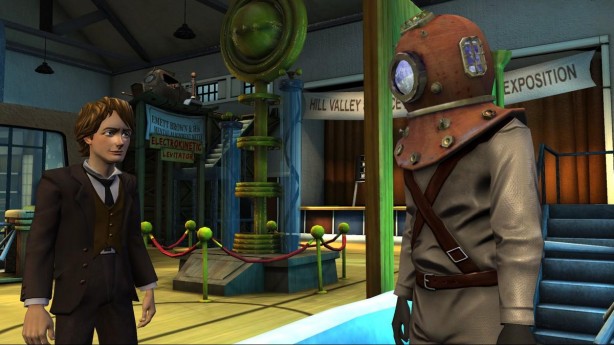
Aside from the two main stars, Biff and the McFly family are all ably acted by replacement actors, whilst some characters such as Marty’s girlfriend Jennifer are actually voiced by the original actors. And if you play all the way through to episode five, you will be treated to a couple of well-publicised cameos from Michael J. Fox himself. All in all, the voice cast adds greatly to the atmosphere, and none of the character voices seem unnatural or out of place.
As mentioned earlier, all of the sound effects you recognise from the films are also faithfully re-recorded. The Time Machine time circuits switching on and off, the flux capacitor… fluxing, all of the sounds conjure up memories from the series. All of these details have been handled with great care, to ensure the immersion into the world is as absolute as possible, and nothing has been done by half measures. It is great to hear the whoosh of the DeLorean hitting eighty-eight miles per hour and disappearing in a burst of flames once again.
GAMEPLAY: The game is very successful at making both seasoned Adventure Game players and newcomers (who may simply be fans of the films) comfortable from the first few scenes. The opening section of the game is immediately recognisable as the scene of the first time travel experiment, in the parking lot of the Twin Pines Mall. Players enter the shoes of Marty and interact with Doc, choosing to either mirror the events of the film perfectly, or select different dialogue options if they like. Tutorial windows will explain the controls and, being completely mouse-controlled, gamers will soon pick them up. By re-using this section of the film for a tutorial, it is instantly familiar to anyone who has seen the film, and will make users feel like they are already immersing themselves into the story as they can now dictate what happens next!
Using the mouse-based control method, players perform a dragging action to move Marty around the different environments, and a simple point-and-click multi-purpose cursor is used for all actions, such as conversation, interaction and manipulating objects. With a simple inventory system at their fingertips, players can examine and store items for future use, taking them out to activate when the need arises. Puzzles within the game range from these inventory-based interactions, to distracting or fooling other NPCs, or even some slightly more action-oriented evasion puzzles. Conversations are tree-based, where users must select correct questions or responses in order to advance the story successfully. Whilst providing some challenge for the little grey cells, puzzles do tend to err on the side of simplicity, most likely in an attempt to allow the game to appeal to new gamers.
In the adventure gaming tradition however, gamers are never able to die or fail. Incorrect choices or decisions won’t end the game, and will usually only result in a slight reprimand that the action you chose won’t work. This makes for a more relaxed experience, which is more about thinking and working out your next move than having quick reactions. But for those who may struggle with some of the puzzles, there is a very helpful, multi-tiered hint system that can be accessed at all times, providing increasingly more obvious hints the more times you check it for an individual puzzle. Coupled with a “Goal” system, where your current objective can always be checked, it is rare that even novice Adventure Gamers will find themselves stumped for long.
LONGEVITY: All of the episodes feel rather short, especially if you compare the amount of time you actually spent interacting against the time you spend simply watching the story pass you by, there isn’t much to keep you busy. It is likely that hardened adventure game players could breeze through each entry in a few hours, and the whole series in a matter of days, but it is more likely that fans of the film series will prefer to revel in being able to re-visit Hill Valley and its residents.
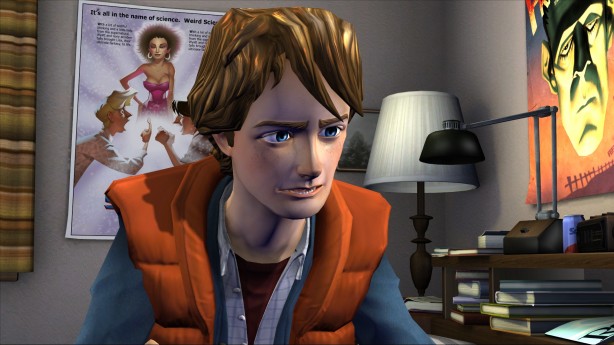
Consequently, the game’s real longevity lies in the fact that fans will want to try all of the different dialogue options available to them, as the writing and wit is very faithful to that of the films. Each action and interaction is therefore an extension of the movies, and fans will relish the chance to be “in” the adventure. Even with that in mind, these different options could probably only warrant a couple of play-throughs for each episode, with there being little in the way of freedom in the title. Progression is pretty linear and most puzzles have a very definitive solution. That said, this is a constant fault with adventure games, and not a problem limited to this series.
VERDICT: Like a film, once enjoyed, a good Adventure Game will have spilled most of its secrets already. But it is the enjoyment claimed on that viewing that is important, and these games do an excellent job of doing justice to the source material. At times, some of the plot twists may feel unnatural for the characters we already know and love so well, but without taking risks and changing the formula, Telltale would be accused of playing it safe.
Twisting what we expect from the familiar characters slightly, whilst maintaining faithful to their core personalities, a host of new situations that weren’t possible in the films are lived out here, by the player. If you ever wondered what it would have been like if Marty met Doc as a teenager his own age, or what Emmett did next after getting married at the end of the third film, this game season feels like a natural and respectable follow-up to the film trilogy.
Telltale have been careful not to mistreat the franchise, as not to disappoint its many enthusiastic fans. Those who aren’t already enamoured to the escapades of Marty and Doc won’t be converted by this season of games, the puzzles are too easy overall and the gameplay can be fairly repetitive. True, there probably isn’t enough actual adventuring to do, with too much emphasis occasionally placed on cinematics, but those who are already devoted to the cause will find much to enjoy. It takes some time to get going, but with constant nods to elements from the films and a great voice-acting cast, we finally have a sequel to the Back To The Future trilogy, after more than twenty-five years. Great Scott!






